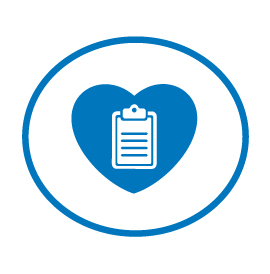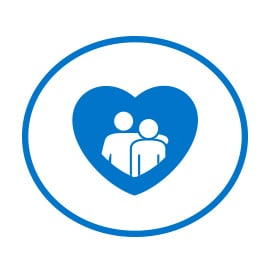At ZOLL®, our aim is to improve patient outcomes with innovative resuscitation and acute critical care technology. Our medical products and software solutions help clinicians, EMS and fire professionals, lay rescuers, and the military provide lifesaving care every day.
Accordingly, ZOLL products and services support the American Heart Association's Chain of Survival, which identifies a sequence of five critical actions that increase survival rates from sudden cardiac arrest (SCA) and other life-threatening emergencies, such as heart attack, stroke, and foreign body airway obstruction.
In-hospital Chain of Survival:

Since medical professionals are properly trained and have access to specialised technology for treating cardiac patients, they follow a certain set of guidelines when responding to sudden cardiac arrest. Following this Chain of Survival gives victims of cardiac arrest a better chance of survival and recovery. The five links used in the adult in-hospital Chain of Survival are:
- Recognition
- Activation of the emergency response system
- Immediate high-quality CPR
- Rapid defibrillation
- Advanced live support and post-arrest care
Out-of-hospital Chain of Survival:

You don't need to be a trained medical professional to help save a life. As a layperson, having an awareness of SCA and knowing how to respond can make all the difference between life and death. If a layperson witnesses sudden cardiac arrest, they should adhere to these five links of the Chain of Survival:
- Activation of the emergency response system
- Immediate high-quality CPR
- Rapid defibrillation
- Basic and advanced emergency medical services
- Advanced life support and post-arrest care
Exploring Each Link in the Chain of Survival
Each link in the Chain of Survival has its own purposes and best practices, which should be observed by both medical professionals and laypersons. Let's properly distinguish each link in the Chain of Survival:

Recognition and activation of the emergency response system
- Assess the emergency and call 999 or the appropriate response system.
- Send someone nearby to retrieve the closest automated external defibrillator (AED). If the location of the AED is not known, locate a staff member in the nearest building.
- Offices, schools, malls, grocery stores, and airports typically have AEDs available.

Immediate high-quality CPR
- Begin high-performance CPR right away to maintain blood flow to vital organs.
- Laypersons should ask for bystander assistance, so each rescuer is performing CPR in 2-minute intervals.
- For adults, deliver compressions to the middle of the chest at a rate of 100-120 per minute and at a depth of 5-6 centimetres (2-2.4 inches), waiting for full chest recoil after each compression.

Rapid defibrillation
- When the AED arrives, attach the pads to the victim's bare chest, turn the device on, and follow the prompts. A shock will be administered automatically if needed.
- Continue administering CPR until emergency personnel arrive.

Basic and advanced emergency medical services (out-of-hospital SCA)
- Trained and equipped pre-hospital EMS personnel take over treatment, continuing to perform CPR, administering drugs and performing advanced airway procedures and other protocols prior to patient's admission to advanced care facility.

Advanced life support and post-arrest care
- Patient receives comprehensive post-SCA treatment in-hospital or at another professional healthcare facility.

Recovery
- SCA survivors should have formal post-event assessments and receive support for their physical, cognitive, and psychosocial needs.
- Survivors and their caregivers need comprehensive discharge planning, including treatment recommendations that support a survivor's return to activities and social/role functioning.
Beyond the Links
For the best chance of surviving an out-of-hospital cardiac arrest, victims should receive CPR and early defibrillation within 3-4 minutes of the cardiac arrest, followed by advanced life support within the first 8 minutes of the arrest.
AHA recommendations:
- All communities should adopt the principle of early defibrillation.
- All personnel who are expected to perform basic CPR as part of their professional duties should be equipped with an AED and be trained to operate it.
- Health and emergency professionals who have a duty to respond to a person in cardiac arrest should have a defibrillator available immediately, or within 1 to 2 minutes at most.
Common Questions about the Chain of Survival
The Chain of Survival is designed to be as accessible as possible. However, rescuers may have a few questions before they feel comfortable following it. Here are some answers to frequently asked questions regarding this process.
When should you begin the Chain of Survival?
The Chain of Survival should be enacted immediately following a reasonable suspicion of sudden cardiac arrest, with bystanders calling emergency services or in-hospital personnel diagnosing the problem. If no pulse is found, then victims must receive CPR and rapid defibrillation within 3 to 4 minutes of cardiac arrest.
What is the Paediatric Chain of Survival?
The Paediatric Chain of Survival outlines the recommended process for helping a child or infant through sudden cardiac arrest. This follows the same general guidelines as the regular Chain of Survival, with a few exceptions: The first link encompasses prevention and early recognition, and the requirements for CPR and defibrillation are adjusted to match the heart rate of a child in his or her age range.
What is rapid defibrillation and why is it important?
Defibrillation is the application of electric shock to an individual's heart to help it beat at a regular rhythm. Rapid defibrillation puts emphasis on quickly using a defibrillator to aid an SCA victim, as doing so helps increase the victim's chance of survival.
Learn More
For more information on how ZOLL technologies and products enhance the Chain of Survival and help save lives, please click on one of the categories: